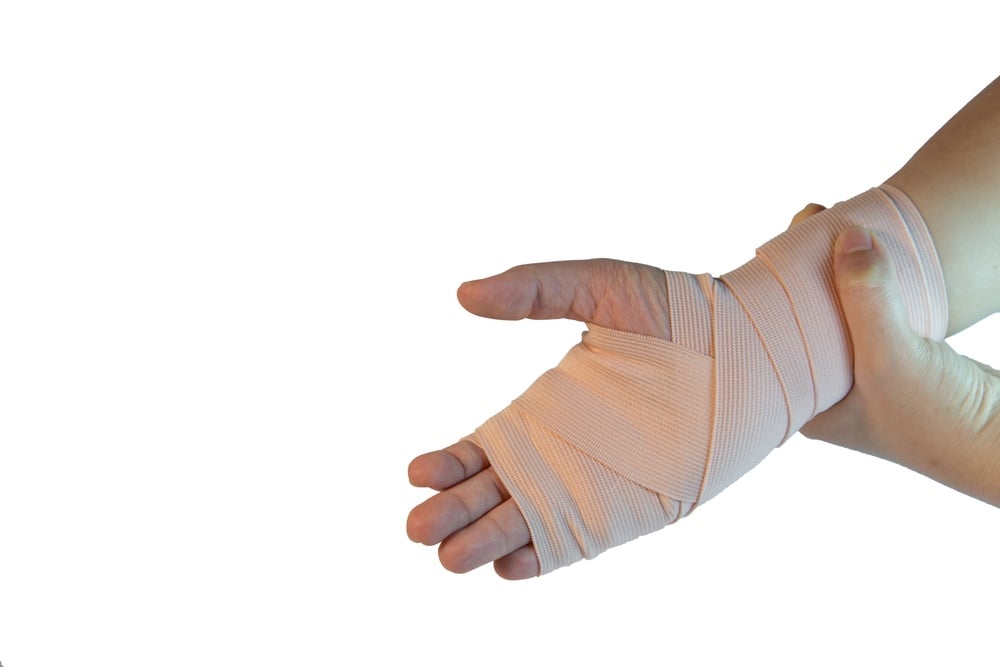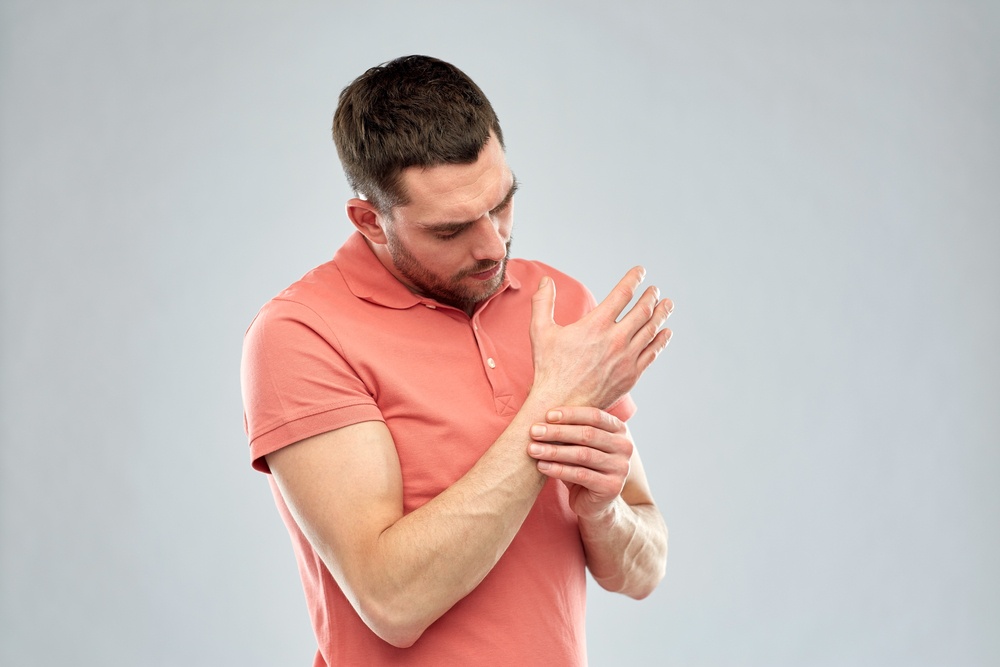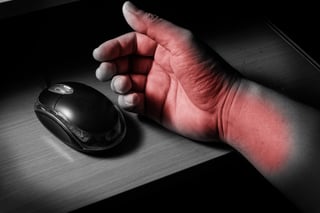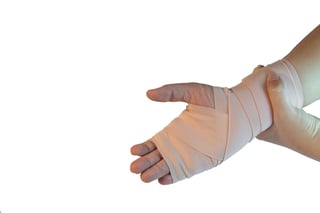Wrist injuries: what kinds, therapy options, common surgeries
July 18th, 2016 | 5 min. read


Is your wrist sore, swollen, tender, or stiff? Wrist pain, especially after a fall or accident, can indicate an injury that may require treatment.
WRIST INJURIES: how they happen
Chronic soreness and repetitive strain injuries can cause pain or weakness that begins gradually and worsens over time.
In the case of an accident, however, you may notice a sudden onset of pain or swelling a day or two after a fall or collision.
People injure their wrists in many different ways. Most commonly, wrist injuries are the result of:
- Falling. Landing on an outstretched hand is the most common cause of sprains, breaks, and other wrist injuries. The classic wrist sprain occurs when falling backwards onto one's hand from a standing position (for example, when losing one's balance skiing, skating, or losing balance on a slippery surface). However, people also sprain their wrists falling forward or landing on their hands (for example, when falling off a bike).
- Lifting. Lifting heavy weight (especially barbells or any object requiring grip strength) can overstretch or strain the joint and muscles of the wrist.

- Performing repetitive motions.
- Sports and activities like bowling, boxing, golf, tennis, volleyball, and even yoga can lead to repetitive strain in the wrist. Weight-bearing activities in particular, like bodybuilding, gymnastics, or using gym equipment, subject the wrist to forces which can lead to injury.
- Certain occupations or hobbies involving bending the wrist joint or gripping objects can also lead to repetitive stress or strain (for example, painting houses, operating heavy machinery, playing a musical instrument, playing video games, or typing).
- Sports and activities like bowling, boxing, golf, tennis, volleyball, and even yoga can lead to repetitive strain in the wrist. Weight-bearing activities in particular, like bodybuilding, gymnastics, or using gym equipment, subject the wrist to forces which can lead to injury.
If you've fallen recently or been in a car accident, you may have experienced a traumatic injury like a sprain, ligament tear, or fracture.
If you're an office worker, "weekend warrior," or athlete, you may be more likely to be suffering from a sports or repetitive strain injury.
wrist injuries: different types
Arthritis
Inflammation, swelling, and aching that gets worse after activity or in cold or damp weather may indicate osteoarthritis (OA) — a degeneration of the articular cartilage covering the ends of the bones. You may also notice your wrist is stiff and tender, and you may hear or sense a grinding in the joint. OA cannot be cured, but symptoms may improve with medication, exercise, and in some cases, surgery.
Carpal tunnel syndrome
Sharp pain that radiates up the arm from the wrist, as well as weakness in the hand and wrist, and numbness, especially in the thumb, may indicate carpal tunnel syndrome (CTS). CTS is commonly known to be an overuse injury in office workers, but it can also be caused by heredity, obesity, pregnancy, and other factors.
Cartilage tears
If the outside of your wrist is sore and swollen, you may have cartilage tears from an overuse injury. Athletes (particularly golfers) often develop tears in the triangular fibrocartilage complex, the stabilizing cartilage at the outside of the wrist. Treatment varies depending on the severity of the injury.
Golfer's wrist (tendonitis)
Gripping a golf club and bending the wrist over and over can lead to soreness, tenderness, and inflammation, especially along the top of the wrist. Wrist tendonitis is most often treated with RICE therapy (see below) and sports medicine, though in some cases platelet-rich-plasma therapy (PRP) has had good results in promoting faster tissue healing.
Wrist fractures
A fracture is a crack or break in one of the bones of the wrist. Wrist fractures are usually caused by falling onto an outstretched hand. Osteoporosis (thinning of the bones) is also a major contributor to wrist breaks in people in their 60s or older.
 Common wrist fractures include:
Common wrist fractures include:
- Hamate fracture, a crack or break in a wrist bone located at the little finger side of the wrist. This injury is often caused by a blow or impact and is frequently seen in golfers who accidentally strike the ground with their clubs.
- Radial fracture at the wrist end of the larger forearm bone. Symptoms include swelling, pain, and possible deformity (you may notice the wrist hanging at an odd angle). Radial fractures require visiting a doctor as soon as possible for diagnosis. The injury may require either non-surgical or surgical treatment, depending on its severity.
- Scaphoid fracture in the bone in the wrist that connects two rows of carpals (small bones) between the forearm and the hand. Symptoms include pain and swelling around the wrist within a few days after falling. Scaphoid fractures don't always show up on X-rays. However, most can be healed by immobilizing the injury. (A doctor visit is advised.)
Depending on the location and severity of your fracture, healing time may be anywhere from 6 to 24 weeks. Treatment may include splinting, a cast, or surgical pinning.
Wrist sprains
Ligaments are bands of connective tissue between the bones of the wrist. When these bands are overstretched beyond their regular range of motion, we call this a sprain. Sprains are most often sustained when one falls on an outstretched hand, forcing the wrist to bend too far.
Symptoms:
If you've suffered a sprain, you may notice:
- pain at the time of injury
- pain when you use your wrist
- swelling, tenderness, or bruising
- a popping or tearing feeling inside the joint
- skin that is warm to the touch around the site of injury
Sprains are graded based on severity. How severe your sprain is dictates how your orthopedist will treat it.
Grade 1 sprains are mild stretches of the wrist ligament.
Grade 2 sprains involve partial ligament tears and may include some loss of function in the wrist.
Grade 3 sprains are the most severe and involve a complete tear. Occasionally, fracturing occurs when the ligament tears under force, pulling off bits of bone. These sprains nearly always require surgery to repair.
If you show signs of a sprain, seeing a doctor is important. An X-ray, MRI, or even arthroscopy (to see the inside of your joint) may be needed to examine your wrist and determine how to treat the injury.
Untreated wrist sprains like a torn ligament in the wrist can lead to ongoing stiffness in the joint. They can also cause imbalances in the mechanics of the wrist and hand. This can contribute to wear and tear on cartilage, which can lead to osteoarthritis.
wrist pain: therapy options

The first step in treating your wrist injury is diagnosis. After a physical exam and tests, your doctor will be able to tell you what kind of damage you've sustained and how to best treat it.
Non-surgical treatment options can include:
- RICE therapy. Especially in the first 48 hours after an acute injury, rest, ice, compression, and elevation above the level of the heart are helpful in controlling swelling and pain.
- NSAIDs. Non-steroidal anti-inflammatory drugs like naproxen and ibuprofen can also help to control inflammation and pain symptoms.
- Casting, taping, wrapping, splinting, or bracing your wrist. An orthopedist or physical therapist can show you how to support your wrist to immobilize it or prevent further damage. In the cases of mild-to-moderate sprains, splinting may be required for one to six weeks. For fractures, wearing a cast may be necessary.
- Physical therapy exercises. Gentle stretches may be prescribed by your doctor to avoid stiffness, particularly if you're splinting your wrist. After surgery, 6 to 8 weeks of physical therapy may be needed to ensure full range of motion.
common surgeries
Seeing an orthopedist is the first step in determining whether surgery may be necessary to treat your wrist injury. Many orthopedists — including Coastal Orthopedics — specialize in treating hand and wrist injuries.
Common wrist surgeries include:
- Carpal tunnel release. This surgery cuts the transverse carpal ligament, increasing the size of the tunnel through which the median nerve travels. Decreased pressure on the nerve can improve symptoms like pain, numbness, and weak grip strength.
- Fracture care. In the case of some wrist fractures, surgical pinning or similar techniques may be required to keep bones in place while they heal.
- Ligament repair. After a serious sprain with a fully torn ligament, an orthopedist may need to surgically reconnect the ligament to the bone. Pins may be required to keep the bones lined up correctly while the torn ligaments heal. Full recovery from this surgery takes about 6 to 8 weeks.
- Ligament reconstruction. Sometimes, older ligament injuries that were left untreated at the time of injury cannot be repaired easily. Reconstruction may be required to address the injury, using a graft from a little-used segment of wrist tendon. Pins are then inserted to hold the wrist bones in place while the newly-grafted segment of tendon heals.
- Fusion. When arthritis and instability of the wrist are problematic, two or more wrist bones can be surgically fused into a single bone. Fusion addresses the pain of "bone-on-bone" arthritis, but it can reduce range of motion.
Coastal Orthopedics regularly treats patients with wrist and hand injuries. Please allow us to help with identifying and treating, or even preventing, your wrist pain. Call us today in Corpus Christi at (361) 248-1253.
Article written by: Rob Williams, MD
Dr. Williams has been practicing orthopedic surgery in Corpus Christi since 1998. After graduating from Texas Tech hereceived his medical degree from the University of Texas at San Antonio. At the prestigious Campbell Clinic located at the University of Tennessee, Dr. Williams completed not only an Orthopedic Surgery Residency, but an additional year of Fellowship Training in Spine Surgery. Dr. Williams is dedicated to creating an excellent patient experience in the office or in the surgery suite.
Topics:

